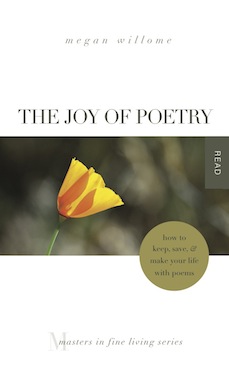The day before I ascended my manuscript into my publisher’s hands, I performed a ritual I use every time I write something big: I drove to Starbucks to read it one last time.
The nearest Starbucks is 30 miles away. It was pouring rain in May, which was ridiculous for this time of year in Central Texas, especially once we realized it would keep raining for days, leading to Memorial Day floods across the region.
On the drive I called my dad to say I was just about finished rewriting, and, oh yeah, the book is now really about Mom and has a bunch of the cancer poems I wrote. He thought that was great. But I was worried. T.S. Poetry Press is not a religious publisher. No one would accidentally come to Jesus reading my book. What would Mom think of that?
That’s when my dad gave me a tremendous gift. He said, “She’s not here.”
With that short sentence I had the all the freedom I needed to finish the book that needed to be written.
Despite the rain, I made it safely to Starbucks and bought a venti-sized tea. After finding a table, I read the manuscript aloud in my head, made a few changes, and sent it off to my publisher the following morning.
That was not the end of the writing process, although my publisher did feel that, yes, this version was much better. I was supposed to have sent an outline first. Oops. Also, during the summer I was asked to change the book’s ending, which I hadn’t done in the rewrite, and to add a couple of chapters, which meant more sheets of notebook paper and more lists. I had found Kathleen Jamie’s poem The Dipper the day I went to Starbucks to do the final read-through. I’m so glad I had time to get permission to include it in the final version.
Months later, shortly before the book was printed, I worked on front matter, permissions, and end notes, including the list of all those poetry permissions I had acquired from publishers. It was as boring as it sounds, but it’s one of the more complicated parts of the process. If I ever write another book which includes references to other published works, I have learned these simple lessons: keep good notes, have a special folder for contracts, and write everything on a digital calendar so I can search it later.
In all, the process of writing The Joy of Poetry stretched from January 1, 2014, to April 1, 2016, when the book was published. That’s two years and three months.
Interestingly, I could not write poems while I was writing about poetry. The few I tried to write weren’t very good. Right before the book came out, I started writing poetry again, even poetry about that other elephant I still can’t talk about directly. Maybe in a few more years, it can come out, stomp around, and make a bunch of noise.
In the end, this four-part series is really a story for writers about being open to what a book needs, even if that may not be apparent at first. Also, know this: what I’ve described in these posts may not work for everyone. But even if you look at what I’ve written and say, “Not this, but that, ” this series will have done its work.
Books are like children. As they grow up, they make their desires known. It behooves us to listen and adjust.
Photo by Philippe Put, Creative Commons, via Flickr. Post by Megan Willome, author of The Joy of Poetry.
Read On Being Asked: Creating The Joy of Poetry – Part 1
Read What to Do with the Elephants: Creating The Joy of Poetry – Part 2
Read R Is for Rewriting: Creating The Joy of Poetry – Part 3
__________
“Megan Willome’s The Joy of Poetry is not a long book, but it took me longer to read than I expected, because I kept stopping to savor poems and passages, to make note of books mentioned, and to compare Willome’s journey into poetry to my own. The book is many things. An unpretentious, funny, and poignant memoir. A defense of poetry, a response to literature that has touched her life, and a manual on how to write poetry. It’s also the story of a daughter who loses her mother to cancer. The author links these things into a narrative much like that of a novel. I loved this book. As soon as I finished, I began reading it again.”
—David Lee Garrison, author of Playing Bach in the D. C. Metro
- Perspective: The Two, The Only: Calvin and Hobbes - December 16, 2022
- Children’s Book Club: A Very Haunted Christmas - December 9, 2022
- By Heart: ‘The night is darkening round me’ by Emily Brontë - December 2, 2022


Donna Falcone says
Megan, a book is a victory. Yes, I read that on a wordcandy once, and it is so spot on.
It really is interesting that you couldn’t write poetry while you were writing about poetry…. hmmm.
I have found a lot of food for thought in your words over the course of this series. Good food. Nourishing food. Thank you.
Donna Falcone says
And oh… your father. Just wow. I’m awestruck by his three words to you, and how he helped you in this with those.
Megan Willome says
Thank you, Donna.
Yes, my dad is one of the most awesome people on the planet.
Laura Lynn Brown says
I love:
• “ascended” as a transitive verb
• “accidentally” (You never know. Someone might.)
• the glimpse of collaboration and (mis)communication between author and publisher
• the reminder to this handwriting advocate to note important dates and milestones on a digital calendar too
• another distinct voice in the great chorus of “let the work be what it wants/needs to be”
Megan Willome says
Thank you, Laura. It really is an amazing process.
L.L. Barkat says
I loved “ascended” as a verb, too.
Hmmm, was it a miscommunication? I was thinking maybe Megan was being funny by saying that. 🙂 As in, she was supposed to do one thing but did a rewrite from the heart instead. (And now I am wanting to know what really happened! 🙂
Megan Willome says
It was not a miscommunication. I wouldn’t know how to do an outline if I were paid for it in cash. All I know how to do is rewrite–hopefully from the heart.
Bethany R. says
“Interestingly, I could not write poems while I was writing about poetry.”
Thanks for including this point. It’s fortifying to know we’re in good company if we go through seasons where one kind of writing is dormant. And it’s encouraging to see that in time—the season can change.
Megan Willome says
This was so shocking to me, Bethany. After I finally finished with the front matter and end notes, there was a short period of time–a week? two?–before the book came out. And that’s when the poems started to come back out too. Boom! There they were.
Christina Hubbard says
Megan, I needed to read this today. Learning about your book process helps me with mine. Taking good notes as I go, and thank you again for writing from the deep places.
Megan Willome says
Thank you, Christina. I do hope it’s helpful for you.
Those deep places–they hurt, but they usually yield treasure.